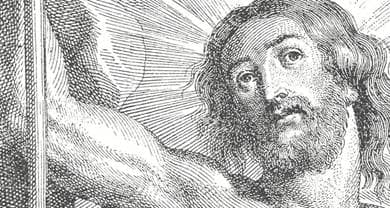- Trending:
- Pope Leo Xiv
- |
- Israel
- |
- Trump
- |
- Social Justice
- |
- Peace
- |
- Love

RELIGION LIBRARY
Anglican/Episcopalian
Early Developments
From the time Queen Elizabeth I came to the throne in 1558 until over a century later, the English Church was pushed and pulled by marginal factions and central authorities alike, all seeking to craft the Church according their vision of right worship and belief. At issue were matters of Church polity, of how worship services were conducted, and of how and to whom God's grace was made available in the Church. The Church would swing from one side to the other, fall into the chaos of war, and eventually emerge somewhere in the middle.
During the reign of Queen Elizabeth I (1558-1603) and for most of the reign of her successor King James I (1603-1626), Protestant beliefs of the Reformed or Calvinist branch predominated in the English Church hierarchy. Doctrinally, this meant that God's grace was found primarily in Bible-based preaching and God's secret, eternal election of certain individuals to eternal life, the rest having been reprobated (predestined to eternal damnation). The true Church was the invisible Church of the elect, and the visible Church was important primarily for the sake of the edification of the elect. Another important component of Elizabethan Calvinism was that the pope was viewed in apocalyptic terms as the Antichrist foretold in the Bible. The Antichrist was seen as a figure associated with the end times, one who would oppose the true Gospel of Jesus Christ, bring general apostasy (rejection of the faith), and have his seat in God's temple (the Church). The pope was believed to fit these characteristics.
The existence of a Calvinist doctrinal hegemony does not mean the Elizabethan and Jacobean Church enjoyed peace and harmony. For instance, there were during this period many Protestants who desired further reform of the Church along the lines of the Reformed churches on the European continent. A number of clergymen were offended by the national requirement to wear what they viewed as "popish" vestments (clerical attire). There was also, particularly during Elizabeth's reign, a popular movement for an egalitarian Church polity based on presbyters rather than bishops and priests. Some groups chose to separate, illegally, from the national Church.
Although Puritanism has been equated with the Presbyterian and/or Separatist movements, it is actually more difficult to pin down than that. It was not a sect, or even a group of sects, but a mindset, an intense belief in the importance of purifying the Church. Some Puritans belonged to sects, some pushed for a presbyterian polity, but some were loyal, conforming members of the national Church of England. Consequently, scholars now tend to think of Puritans broadly as the "hotter sort" of Protestants.
Late in Elizabeth's reign and early in that of James, cracks began to appear in the Calvinist doctrinal hegemony. The doctrine of predestination, particularly reprobation, came under fire at Cambridge. Divines (theologians) such as Richard Hooker, Lancelot Andrewes, and John Overall combined anti-Calvinism and an enhanced ceremonialism in a way that emphasized the importance of the grace available in the sacraments, corporate prayers, and worship according to the Book of Common Prayer (BCP), and that stressed the visible Church as the community of all professing believers. This movement was later known as "avant-garde conformity" because they anticipated more thorough changes along these lines that would occur in the 1620s and 1630s.
During this later period, as the reign of James transitioned to that of his son, Charles I, so-called Arminians began their ascendancy within the power structures of Church and State. The enthronement of William Laud as Archbishop of Canterbury in 1633 both emblemized and secured this rise to power. English Arminianism was the intellectual and liturgical heir of the avant-garde conformists. It was characterized by a prayer- and sacrament-centered piety and strong affinity for elaborate ceremonial, and also by a broad-bottomed vision of the Church as equated with the visible Church. The Arminians also jettisoned the apocalyptic image of the pope as Antichrist--Rome was a true Church, albeit an erroneous one. This was an explosive idea in English Protestant culture. William Laud's church policies and King Charles's absolutist state policies generated widespread anxiety among Puritans of every stripe. Ongoing religious unrest in Ireland and political and religious divisions at home plunged the realm into bloody civil wars, and Laud and Charles were beheaded.Settlement was overturned, meaning the clergy was no longer made up of bishops and priests (although some who had been bishops and priests still served as pastors) and the Book of Common Prayer (BCP) was no longer used for worship. Yet many of the English began to pine for the pre-war Church.
The period from 1642 to 1660, the time of the civil wars and the Interregnum (the period between monarchs), was marked by a complete transformation of the English Church. Presbyterians first succeeded to Church leadership, eventually opposed by the Independents, while a plethora of Protestant sects sprang up. Lord Protector Oliver Cromwell, supporting the Independents, imposed a Puritan regime, a godly Commonwealth that he was, he believed, appointed by God to institute. The Elizabethan Settlement was overturned, meaning the clergy was no longer made up of bishops and priests (although some who had been bishops and priests still served as pastors) and the Book of Common Prayer (BCP) was no longer used for worship. Yet many of the English began to pine for the pre-war Church.
They got their wish after the Restoration of the monarchy in 1660, when Charles II was crowned king. The Church was returned to its episcopal structure, and a new edition of the BCP was issued in 1662. Sects were permanently marginalized. Calvinist predestinarianism, now associated with Cromwell and the Puritans, no longer prevailed in the Church of England, but neither did the extremes of Arminianism. A non-Arminian, non-Calvinist balance was found, at least for the moment. This was the beginning of Anglicanism, of a Church with a self-identity as a via media, drawing on both Catholic and Reformed, and reducible to neither.
Study Questions:
1. Describe the connection between Anglicanism and monarchy.
2. What were the doctrinal beliefs of Elizabethan Calvinism?
3. How did English Arminianism develop? What do followers believe?
4. When could it be argued that Anglicanism began?










